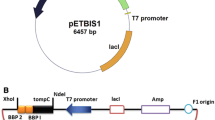Abstract
For the construction of an efficient copper waste treatment system, a cell surface display strategy was employed. The copper adsorption ability of recombinant bacterial strains displaying three different copper binding peptides were evaluated in LB Luria–Bertani medium (LB), artificial wastewater, and copper phthalocyanine containing textile dye industry wastewater samples. Structural characteristics of the three peptides were also analyzed by similarity-based structure modeling. The best binding peptide was chosen for the construction of a dimeric peptide display and the adsorption ability of the monomeric and dimeric peptide displayed strains were compared. The dimeric peptide displayed strain showed superior copper adsorption in all three tested conditions (LB, artificial wastewater, and textile dye industry wastewater). When the strains were exposed to copper phthalocyanine dye polluted wastewater, the dimeric peptide display [543.27 µmol/g DCW dry cell weight (DCW)] showed higher adsorption of copper when compared with the monomeric strains (243.53 µmol/g DCW).




Similar content being viewed by others
References
Pazirandeh M, Wells BM, Ryan RL (1998) Development of bacterium-based heavy metal biosorbents: enhanced uptake of cadmium and mercury by Escherichia coli expressing a metal binding motif. Appl Environ Microbiol 64:4068–4072
Guerra FP, Reyes L, Vergara-Jaque A, Campos-Hernández C, Gutiérrez A, Pérez-Díaz J, Pérez-Díaz R, Blaudez D, Ruíz-Lara S (2015) Populus deltoides Kunitz trypsin inhibitor 3 confers metal tolerance and binds copper, revealing a new defensive role against heavy metal stress. Environ Exp Bot 115:28–37
Fu L-Y, Wen X-H, Xu L-J, Qian Y (2002) Removal of a copper-phthalocyanine dye from wastewater by acclimated sludge under anaerobic or aerobic conditions. Process Biochem 37:1151–1156
Silva MC, Corrêa AD, Amorim MTSP, Parpot P, Torres JA, Chagas PMB (2012) Decolorization of the phthalocyanine dye reactive blue 21 by turnip peroxidase and assessment of its oxidation products. J Mol Catal B Enzym 77:9–14
Tunali S, Çabuk A, Akar T (2006) Removal of lead and copper ions from aqueous solutions by bacterial strain isolated from soil. Chem Eng J 115:203–211
Sheng PX, Ting YP, Chen JP, Hong L (2004) Sorption of lead, copper, cadmium, zinc, and nickel by marine algal biomass: characterization of biosorptive capacity and investigation of mechanisms. J Colloid Interface Sci 275:131–141
Igberase E, Osifo P, Ofomaja A (2014) The adsorption of copper (ii) ions by polyaniline graft chitosan beads from aqueous solution: equilibrium, kinetic and desorption studies. J Environ Chem Eng 2:362–369
Ni H, Xiong Z, Ye T, Zhang Z, Ma X, Li L (2012) Biosorption of copper(II) from aqueous solutions using volcanic rock matrix-immobilized Pseudomonas putida cells with surface-displayed cyanobacterial metallothioneins. Chem Eng J 206:264–271
Saleem M, Brim H, Hussain S, Arshad M, Leigh MB, Zia UH (2008) Perspectives on microbial cell surface display in bioremediation. Biotechnol Adv 26:151–161
Bae W, Wu CH, Kostal J, Mulchandani A, Chen W (2003) Enhanced mercury biosorption by bacterial cells with surface-displayed MerR. Appl Environ Microbiol 69:3176–3180
Lee SY, Choi JH, Xu Z (2003) Microbial cell-surface display. Trends Biotechnol 21:45–52
Ravikumar S, I-k Yoo, Lee S, Hong S (2011) Construction of copper removing bacteria through the integration of two-component system and cell surface display. Appl Biochem Biotechnol 165:1674–1681
Xu Z, Lee SY (1999) Display of polyhistidine peptides on the Escherichia coli cell surface by using outer membrane protein C as an anchoring motif. Appl Environ Microbiol 65:5142–5147
Cruz N, Le Borgne S, Hernández-Chávez G, Gosset G, Valle F, Bolivar F (2000) Engineering the Escherichia coli outer membrane protein OmpC for metal bioadsorption. Biotechnol Lett 22:623–629
Link AJ, Tirrell DA (2003) Cell surface labeling of Escherichia coli via copper(I)-catalyzed [3+2] cycloaddition. J Am Chem Soc 125:11164–11165
Rodríguez Couto S (2009) Dye removal by immobilised fungi. Biotechnol Adv 27:227–235
Laemmli UK (1970) Cleavage of structural proteins during the assembly of the head of bacteriophage T4. Nature 227:680–685
Shishir KB, Murthy DVS (2008) Effect of hydraulic retention time and initial nitrate concentration on the performance of an upflow anoxic bioreactor: a factorial design study. Indian Chem Eng 50:27–33
Choi JH, Choi Jong-IL, Lee SY (2005) Display of proteins on the surface of Esherichia coli by C-terminal deletion fusion to the Salmonella typhimurium OmpC. J Microbiol Biotechnol 15(1):141–146
Altschul SF, Gish W, Miller W, Myers EW, Lipman DJ (1990) Basic local alignment search tool. J Mol Biol 215:403–410
Zahn R (2003) The octapeptide repeats in mammalian prion protein constitute a pH-dependent folding and aggregation site. J Mol Biol 334:477–488
Hodak M, Chisnell R, Lu W, Bernholc J (2009) Functional implications of multistage copper binding to the prion protein. Proc Natl Acad Sci USA 106:11576–11581
Millhauser GL (2004) Copper binding in the prion protein. Acc Chem Res 37:79–85
Eswar N, Webb B, Marti-Renom MA, Madhusudhan MS, Eramian D, Shen MY, Pieper U, Sali A (2001) Comparative protein structure modeling using MODELLER. In: Curr. Protoc. Protein Sci. Wiley
Acknowledgments
This work was supported by the 2014 Research Fund of the University of Ulsan.
Author information
Authors and Affiliations
Corresponding author
Electronic supplementary material
Below is the link to the electronic supplementary material.
Rights and permissions
About this article
Cite this article
Maruthamuthu, M.k., Nadarajan, S.P., Ganesh, I. et al. Construction of a high efficiency copper adsorption bacterial system via peptide display and its application on copper dye polluted wastewater. Bioprocess Biosyst Eng 38, 2077–2084 (2015). https://doi.org/10.1007/s00449-015-1447-y
Received:
Accepted:
Published:
Issue Date:
DOI: https://doi.org/10.1007/s00449-015-1447-y




